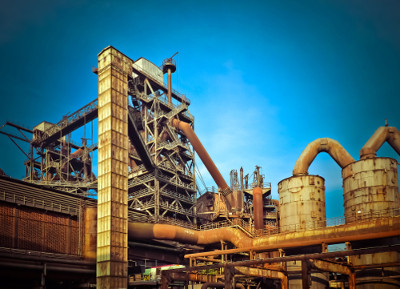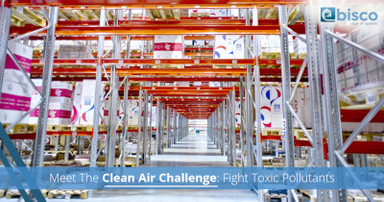Jan 20th 2018
Meet The Clean Air Challenge: Fight Toxic Pollutants
General contractors have the unique privilege to specialize in a field that gets to work with so many different industries. As contractors, they can manage any type of construction project, which connects them to business owners in the manufacturing, healthcare, office, industrial, sports and event centers, corporate, education, scientific and lab, transportation, renewable energy, and even more. Each one of these types of clients has different needs from the next.
One thing that is becoming more popular is a move toward “Green Building”. LEED certifications have made it possible to track the environmental friendliness of a building throughout construction, awarding businesses who have taken the extra step toward saving the earth during construction and operation of the facility.
Whether it’s because of conscientious business owners or increased regulations, general contractors are frequently required to meet high standards for cleanliness during construction as well as innovation for building clean facilities.
Clean facilities are especially important to manufacturing, healthcare, industrial, and scientific and lab industries. Healthcare and scientific and lab facilities have high cleanliness regulations because of the nature of their clientele who visit the space. There is no room for excessive dirt, dust, grime, or particles when people are sick or experiments are conducted at specific chemical levels. And while manufacturing and industrial work spaces are not usually concerned about sick patients or chemical experiments, they do tend to create excessive amounts of pollution that needs to be effectively filtered and disposed before it contaminates the health of employees working inside or of the surrounding environment.
For these reasons, general contractors have joined together to fight toxic pollutants for cleaner air. Led by the Associated General Contractors, contractors from around the nation have made a conscious and deliberate effort to fight toxic pollutants during construction that not only keep the job clean as it is in progress but set up the new business for success when it comes to clean air and a clean facility during operation.
One person or general contractor can surely make a difference, but the results are exponential when hundreds of contractors around the nation join together to meet one challenge.
We’ve Come This Far Already
The Associated General Contractors, Oregon Columbia Chapter, reported in 2016 on the progress the nation has made toward better pollution control with the help of the Clean Air Act (CAA) that passed in 1970. The report says that stationary sources today emit 1.5 million tons less air pollution per year since 1990. What an improvement!

For a practical example, Oregon Columbia Chapter partnered with the Oregon Department of Environmental Quality and the EPA to make it a requirement to include pollution prevention as a permit for all construction jobs.
Despite population growing 54 percent and Gross Domestic Product increasing by 243 percent in the 40+ years the CAA has been in effect, the United States has successfully reduced aggregate emissions by 70 percent.
The United States relies on the public and private sectors to prioritize clean air for the sake of people’s health and of the environment. One such reason we’ve made incredible progress so far is because of the scientific and technological innovations that have spurred to help businesses meet the strict requirements of the CAA.
Together with improving technology, scientific data to support efforts, and people willing to put in the extra time and effort to clean air, the health of the people and of the earth will continue to progress.
How You Can Help Progress
General contractors can make a conscious effort with each project under construction to make sure polluting behavior is limited, the surrounding population is affected as minimally as possible, and pollution alternatives are considered.
Additionally, two key ways contractors can decrease their footprint during construction is to upgrade old and outdated equipment for new machines and tools that have better emission control, and to look for cleaner fuel alternatives and use electricity when possible.
Lastly, one integral way contractors can decrease toxic pollutants is by installing equipment and features in the buildings that will help them operate at a cleaner level throughout their lifetimes.
Bisco Wants To Help
For about as long as the CAA has been in effect, more than 40 years, Bisco Enterprise has been an industry leader in air cleaning and dust removal products and systems. We push ourselves to be on the breaking edge of technology and innovation as we develop the widest range of air cleaning systems available on the market.
But we don’t stop at the products alone.
Our team offers general contractors and business owners support from factory trained technicians before and after installation to make sure the ideal results are achieved.
Some of our most popular systems for commercial buildings that need to take an additional step toward clean air include dust collectors, mist collectors, fume collectors, and vacuum systems.
- Dust collectors: Owners or contractors can choose between a central or portable dust collection system. Systems vary to account for wood, paper, or plastic dust, among other helpful features to streamline the pollutant removal process. You can even select a wet-type dust collector for all flammable and nonflammable metal dust contaminants.
- Mist collectors: Whether you need to collect oil, dust, smoke, fume, or gas/vapor contaminants, Bisco Enterprise has a mist collector or filtration system to get the job done well for many years.
- Fume collectors: Protect against toxins from solvents, spot/TGI welding, screen printing, adhesives and more with a bench top extraction kit or an extractor arm that helps mitigate fume pollution, which can be extremely toxic for employees, clients, or students who may be using the materials.
- Vacuum systems: Wet vacuums, dry vacuums, or the all-in-one wet/dry vacuums make up the majority of vacuum systems from Bisco Enterprise. These systems can remove larger granules of liquids and sludge or dry substances.
As mentioned, Bisco Enterprise offers support both before and after the purchase of one of our air cleaner systems in order to best help contractors and business owners meet the challenges of reducing toxic pollutants from the air.
Reach out to us today to learn more about which system will be best for your job.
So, today, we extend this challenge to you: Help rid the world of toxic pollutants by focusing on clean air.


